
31 Results


The topics covered under this course include elements of nuclear physics for engineering students, basic properties of the nucleus and nuclear radiations, quantum mechanical calculations of deuteron bound-state wave function and energy, n-p scattering cross-section, transition probability per unit time and barrier transmission probability. Also explored are binding energy and nuclear stability, interactions of charged particles, neutrons, and gamma rays with matter, radioactive decays, energetics and general cross-section behavior in nuclear reactions.
- Subject:
- Applied Science
- Engineering
- Environmental Science
- Physical Science
- Physics
- Material Type:
- Full Course
- Provider Set:
- MIT OpenCourseWare
- Author:
- Chen, Sow-Hsin
- Date Added:
- 09/01/2003

This video segment adapted from A Science Odyssey takes a look at the scale of the atom and the tremendous amount of space between the electrons and the nucleus. If all this empty space exists in matter, how can any substance be solid?
- Subject:
- Chemistry
- Physical Science
- Physics
- Material Type:
- Activity/Lab
- Provider:
- PBS LearningMedia
- Provider Set:
- PBS Learning Media: Multimedia Resources for the Classroom and Professional Development
- Author:
- National Science Foundation
- WGBH Educational Foundation
- Date Added:
- 01/22/2004

Biology is designed for multi-semester biology courses for science majors. It is grounded on an evolutionary basis and includes exciting features that highlight careers in the biological sciences and everyday applications of the concepts at hand. To meet the needs of today’s instructors and students, some content has been strategically condensed while maintaining the overall scope and coverage of traditional texts for this course. Instructors can customize the book, adapting it to the approach that works best in their classroom. Biology also includes an innovative art program that incorporates critical thinking and clicker questions to help students understand—and apply—key concepts.
- Subject:
- Biology
- Life Science
- Material Type:
- Full Course
- Provider:
- Rice University
- Provider Set:
- OpenStax College
- Date Added:
- 08/22/2012

- Subject:
- Biology
- Life Science
- Material Type:
- Unit of Study
- Provider:
- Rice University
- Provider Set:
- OpenStax College
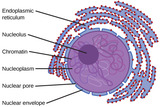
By the end of this section, you will be able to:Describe the structure of eukaryotic cellsCompare animal cells with plant cellsState the role of the plasma membraneSummarize the functions of the major cell organelles
- Subject:
- Applied Science
- Biology
- Life Science
- Material Type:
- Module
- Date Added:
- 07/10/2017

- Subject:
- Applied Science
- Biology
- Life Science
- Material Type:
- Module
- Date Added:
- 07/10/2017
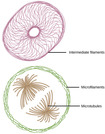
By the end of this section, you will be able to:Describe the cytoskeletonCompare the roles of microfilaments, intermediate filaments, and microtubulesCompare and contrast cilia and flagellaSummarize the differences among the components of prokaryotic cells, animal cells, and plant cells
- Subject:
- Applied Science
- Biology
- Life Science
- Material Type:
- Module
- Date Added:
- 07/10/2017

- Subject:
- Biology
- Life Science
- Material Type:
- Unit of Study
- Provider:
- Rice University
- Provider Set:
- OpenStax College

By the end of this section, you will be able to:Define matter and elementsDescribe the interrelationship between protons, neutrons, and electronsCompare the ways in which electrons can be donated or shared between atomsExplain the ways in which naturally occurring elements combine to create molecules, cells, tissues, organ systems, and organisms
- Subject:
- Applied Science
- Biology
- Life Science
- Material Type:
- Module
- Author:
- Tina B. Jones
- Date Added:
- 08/26/2019

By the end of this section, you will be able to:Define matter and elementsDescribe the interrelationship between protons, neutrons, and electronsCompare the ways in which electrons can be donated or shared between atomsExplain the ways in which naturally occurring elements combine to create molecules, cells, tissues, organ systems, and organisms
- Subject:
- Applied Science
- Biology
- Life Science
- Material Type:
- Module
- Date Added:
- 07/10/2017

- Subject:
- Applied Science
- Biology
- Life Science
- Material Type:
- Module
- Date Added:
- 07/10/2017
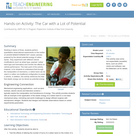
Working in teams of three, students perform quantitative observational experiments on the motion of LEGO MINDSTORMS(TM) NXT robotic vehicles powered by the stored potential energy of rubber bands. They experiment with different vehicle modifications (such as wheel type, payload, rubber band type and lubrication) and monitor the effects on vehicle performance. The main point of the activity, however, is for students to understand that through the manipulation of mechanics, a rubber band can be used in a rather non-traditional configuration to power a vehicle. In addition, this activity reinforces the idea that elastic energy can be stored as potential energy.
- Subject:
- Applied Science
- Chemistry
- Engineering
- Physical Science
- Material Type:
- Activity/Lab
- Provider:
- TeachEngineering
- Provider Set:
- TeachEngineering
- Author:
- Brian Kay
- Daria Kotys-Schwartz
- Janet Yowell
- Malinda Schaefer Zarske
- Date Added:
- 09/18/2014

The goal of this course is to teach both the fundamentals of nuclear cell biology as well as the methodological and experimental approaches upon which they are based. Lectures and class discussions will cover the background and fundamental findings in a particular area of nuclear cell biology. The assigned readings will provide concrete examples of the experimental approaches and logic used to establish these findings. Some examples of topics include genome and systems biology, transcription, and gene expression.
- Subject:
- Biology
- Life Science
- Material Type:
- Full Course
- Provider Set:
- MIT OpenCourseWare
- Author:
- Sharp, Phillip
- Young, Richard
- Date Added:
- 02/01/2010

This resource is a video abstract of a research paper created by Research Square on behalf of its authors. It provides a synopsis that's easy to understand, and can be used to introduce the topics it covers to students, researchers, and the general public. The video's transcript is also provided in full, with a portion provided below for preview:
"Critical defects that compromise the nucleus during cell division could be the basis for the age-accelerating effects of people living with progeria. Hutchinson-Gilford progeria syndrome is a genetic disorder that causes premature aging. Affecting one in 8 million newborns worldwide, the disorder is extremely rare—and fatal. The rapid aging of the cardiovascular system causes death due to heart attack or stroke in patients by their mid-teens. Progeria is caused by a tiny point mutation in the lamin A gene. This gene is responsible for producing structural proteins called lamins, which form the scaffolding that holds the cell nucleus together. The mutated form of prelamin A called progerin destabilizes the cell nucleus—the genetic control center of cells. The result is the fast-aging effects observed in progeria. But the link from gene mutation to physical disorder has remained a mystery. Previous studies have looked only at models of progeria, not at actual patient cells..."
The rest of the transcript, along with a link to the research itself, is available on the resource itself.
- Subject:
- Applied Science
- Health, Medicine and Nursing
- Material Type:
- Diagram/Illustration
- Reading
- Provider:
- Research Square
- Provider Set:
- Video Bytes
- Date Added:
- 09/20/2019

"The Chemistry of Power: A Comprehensive Guide to Nuclear Energy is a carefully designed unit for Chemical Engineering students and lecturers. It is divided into three lessons, each lesson breaks down complex concepts into simple, bite-sized pieces, ensuring a smooth learning experience for all.In Lesson 1, "Understanding Key Terms in Nuclear Energy," we start by learning the basic words used in nuclear energy, like atomic mass and binding energy. Through clear examples, you'll grasp these important ideas and get ready for more challenging stuff.Lesson 2, "Energy Basics," builds on what we've learned. Here, we dive into how energy and mass are connected, making it easier to understand how nuclear reactions work. You'll follow along step by step, so everything stays clear and straightforward.Finally, Lesson 3, "Nuclear Energy Calculations," puts your new skills to the test. You'll solve problems and work together with others to understand how to turn energy into mass and back again. It's like a puzzle, but once you've got it, you'll feel super smart!By following these lessons in order, you'll gradually become a pro in nuclear energy, understanding the ins and outs of how it all works.
- Subject:
- Applied Science
- Engineering
- Material Type:
- Unit of Study
- Author:
- Lotachukwu Ernest Eze
- Date Added:
- 03/18/2024
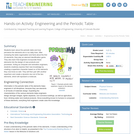
Students learn about the periodic table and how pervasive the elements are in our daily lives. After reviewing the table organization and facts about the first 20 elements, they play an element identification game. They also learn that engineers incorporate these elements into the design of new products and processes. Acting as computer and animation engineers, students creatively express their new knowledge by creating a superhero character based on of the elements they now know so well. They will then pair with another superhero and create a dynamic duo out of the two elements, which will represent a molecule.
- Subject:
- Applied Science
- Chemistry
- Engineering
- Physical Science
- Material Type:
- Activity/Lab
- Provider:
- TeachEngineering
- Provider Set:
- TeachEngineering
- Author:
- Brian Kay
- Denise W. Carlson
- Lauren Cooper
- Malinda Schaefer Zarske
- Megan Podlogar
- Date Added:
- 10/14/2015
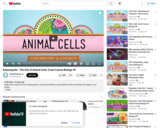
Hank tells us about the city of Eukaryopolis - the animal cell that is responsible for all the cool things that happen in our bodies.
Chapters:
1) Robert Hooke
2) Cilia/Flagella
3) Cell Membrane
4) Cytoplasm/Cytoskeleton/Centrosomes
5) Endoplasmic Reticulum
6) Ribosomes
7) Golgi Apparatus
8) Lysosomes
9) Nucleus
10) Mitochondria
- Subject:
- Biology
- Life Science
- Material Type:
- Lecture
- Provider:
- Complexly
- Provider Set:
- Crash Course Biology (2012)
- Date Added:
- 02/20/2012

This text been designed for an undergraduate human anatomy and physiology course at a medium sized public university. This text has been modified from the original OpenStax text to encourage more active reading for an early undergraduate student taking the first semester of a year-long human anatomy and physiology course sequence. This text has been targeted to our student population, consisting primarily of first semester pre-nursing and kinesiology majors at a university with a high proportion of first generation and PELL-eligible students who benefit from lower barriers to entry into the field. Therefore, freely-available and differently presented text can be beneficial to this student population. This version was designed with the intention of distributing it section by section through a learning management system. If this mode of distribution is used, connection to an assessment tool could be utilized. Systems covered include skeletal, muscular, cardiovascular, respiratory, and nervous.
As this text reorganizes and modifies an OpenStax’s Anatomy and Physiology 2e (see related resources link below), chapter numbers and chapter section numbers from the original have been preserved in this document. Material supplemented from other sources is cited within the text.
Course connections: Undergraduate courses aimed towards freshmen or sophomore, including Anatomy and Physiology, Introduction to Anatomy and Physiology, Physiology, Introduction to Physiology, Human Biology or similar with a human focus.
- Subject:
- Anatomy/Physiology
- Biology
- Life Science
- Material Type:
- Textbook
- Author:
- Megan Sherbenou
- Date Added:
- 06/27/2024

In this course, we will explore what makes things in the world the way they are and why, to understand the science and consider the engineering. We learn not only why the physical world behaves the way it does, but also how to think with chemical intuition, which can’t be gained simply by observing the macroscopic world.
This 2018 version of 3.091 by Jeffrey Grossman and the 2010 OCW version by Don Sadoway cover similar topics and both provide complete learning materials. This 2018 version also includes Jeffrey Grossman’s innovative Goodie Bags, Why This Matters, and CHEMATLAS content, as well as additional practice problems, quizzes, and exams.
- Subject:
- Applied Science
- Chemistry
- Engineering
- Physical Science
- Material Type:
- Full Course
- Provider Set:
- MIT OpenCourseWare
- Author:
- Grossman, Jeffrey
- Date Added:
- 09/01/2018